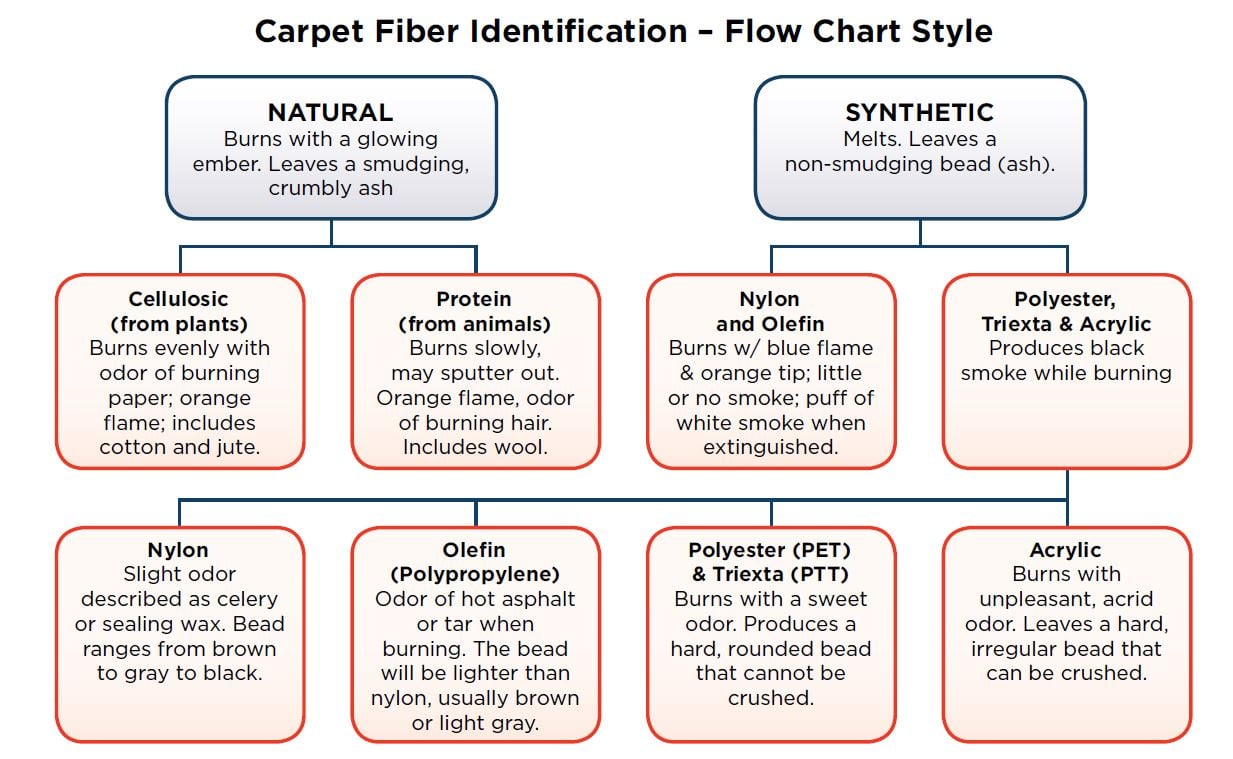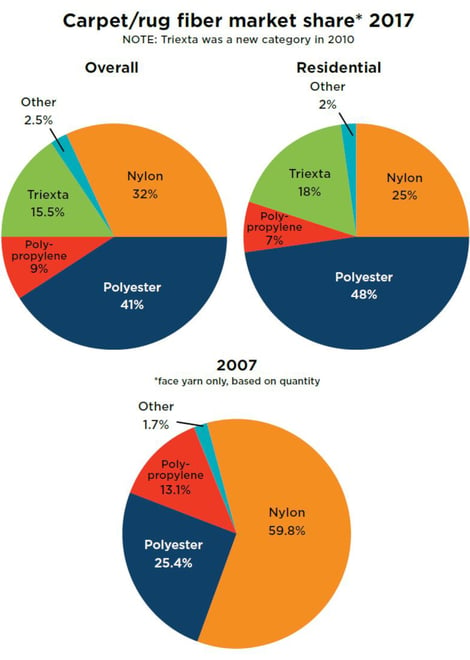Are you really cleaning what you think you are cleaning? You may be cleaning the wrong carpet or carpet that is not what you think it is.
You cannot always tell what carpet fiber you are cleaning just by looking at it. Because nylon was the gold standard in synthetic carpet fibers for many decades, carpet manufacturers worked hard to make their ole-fin, polyester, and Triexta fibers resemble nylon.Each fiber has different properties that are evident in the types of soil it releases or holds onto. For example, Triexta and polyester absorb almost no water and naturally shed watery liquids. But they love oil. Olefin is more likely to hold tightly to fine abrasive soil particles due to van der Waals forces. Various presprays are formulated to attack specific soils or work with specific fibers.
Benefits of fiber ID
Knowing the fiber you are cleaning can help you select the best possible cleaning agents. Fiber identification is also helpful in managing client expectations. The differences in fibers mean not only a different response to cleaning but also to traffic and wear as the carpet ages. If customers have experience with the resiliency of nylon, they may be disappointed in how polyester holds up to heavy traffic. Help your customer know what to expect. It can save you a callback.
Performing a fiber ID test will also set your company apart from 95% of the potential competition that does not do fiber ID. Testing and explaining the process to your curious customer provides a great opportunity to sell the quality of your service. You are selecting a cleaning approach custom matched to their carpet.
You likely know how to do a burn test. However, a burn test does not always distinguish between nylon and olefin. Formic acid often sold as a Fiber ID solution, allows you to positively identify nylon fibers. Test. For-mic acid will quickly melt nylon but not other synthetic carpet fibers. Be careful how and where you perform this test. Formic acid is stinging venom produced by fire ants. You don’t want this on your skin, anyone else’s skin, or on nylon carpet other than the tuft you are testing. (See Figure 1 for a detailed burn chart.)
*Figure 1

Statistics
Figure 2 shows that nylon carpets lost over half of their share of the residential market from 2007 to 2017. Polypropylene (olefin) has lost almost half of its residential market share during the same time span. Polyester has almost doubled its market share since 2007. If you include Triexta (a variation of polyester) then polyester has almost tripled its market share in residential carpets since 2007.
No wonder, the carpet cleaner needs to be able to identify the fiber before cleaning it. Ten years ago, you could assume a carpet was nylon since polyester held only 25% of the market. Today the reverse is true with nylon making up only 25% of new residential carpet sales.
Cleaning problems
Nylon carpet fibers — both type 6 and 6, 6 — recover well from stretch and are less likely to break than polyester. They also have excellent resiliency and recovery from bending deformation, which means they are less likely to crush and mat than olefin, polyester (PET), or Triexta (PTT).*
Olefin and polyester abrade or become scratched easier than nylon. Actually, nylon is a polyamide fiber and is related to the fibers used to reinforce radial tires and Kevlar which is used in bulletproof vests. Nylon does abrade, but not easily.
Therefore, your clients are likely to see much more damage to their carpet’s face yarns than previously. Matting, crushing, stretching, and abrasion is all fiber characteristics and are the result of wear, so they do not reflect the thoroughness of the cleaning. But, the customer may feel his new carpet does not respond as well to cleaning as their former nylon carpet did. Be sure to set proper expectations.
Olefin and, to a lesser extent, polyester and triexta repel water but have an affinity for or attraction to oils. This includes petroleum products like motor oils and asphalt that might be tracked from a parking area. With time and oxidation, these oils become part of the fiber and impart a yellow or brown color. This may appear as a pathway, with the greatest discoloration beginning at the front door. The affinity for oils also includes cooking oils such as vegetable and olive oils. These are dispersed from the cooking area by air currents and eventually are pulled to the carpet by gravity.
Chemistry
There are several products that you will want to have available to produce the best cleaning results.
The standard high pH degreasing prespray is usually the first and best choice for a fiber that loves oil. This is especially true for homes where the kitchen is obviously used. However, when this is not the case because abrasive dry particles are the major soil load, a prespray that utilizes a cationic hydrotrope to draw soils from the carpet and hold them in suspension until the carpet is rinsed is an excellent choice. This type of product does not need to be a high pH, as it is the special surfactant blend of nonionics and cationics that does the bulk of the work.
Citrus boosters can be added to either type of prespray to enhance degreasing. Oxidizers can be used when lighter colors are used in the fiber and need to be highlighted. Using a phosphate-based rinse along with soft water will more readily remove the suspended globs of soil and oils. The most advanced chemistry will make the cleaning task much easier, giving better results and saving time.
Procedures
Polyester and olefin should be cleaned frequently before oils have time to bond with fibers and oxidize. In addition to the chemistry mentioned previously, high heat and agitation are helpful to break bonds between the fibers and oils.
Be cautious with heat. Hot solution hoses or quick connects that remain in one place for an extended time can mark the carpet. Consider the use of safe connects or wrap to protect the carpet. Mechanical action with a counter-rotating brush helps lift the pile to reduce matting while also separating oils and other soils from the carpet.
Wicking during the drying process is a common issue with polyester and olefin since they are hydrophobic (or water-hating) fibers. Complete and thorough vacuuming is the first step to preventing or reducing wicking. Soiling that is removed from the carpet has no chance to wick to the surface. Generally, dry soils are easier to remove than wet.
These fibers absorb very little moisture. Whatever liquids are applied to the carpet face immediately begin to travel down the tuft toward the base of the carpet. Multiple, slow extraction passes help remove that water along with the dissolved and suspended contaminants.
Post bonneting can remove excess moisture and soil that may have begun to wick. Encapsulation products sprayed on the following extraction also reduce wicking. Air movement from air movers or the client’s ceiling fans and HVAC system will speed drying and also help reduce wicking.
Protective treatments
Ten years ago, most after-market protectors were designed for nylon. Nylon dominated the marketplace since olefin and polyester were secondary with significant gaps in cost. Even though polyester and olefin were in the marketplace, their cost and volume did not justify developing specialized protective treatments. Triexta filled the cost gap between nylon and the other fibers so that protective treatments became a viable option.
However, the Triexta carpet was originally advertised as needing no protection since the fibers would not stain. Over time, the oleophilic nature of Triexta fiber results in the bonding of oils onto the fiber, which attracts soil and makes it a difficult carpet to clean effectively. This resulted in the creation of a Triexta carpet fiber with outstanding oil and water resistance along with claims that it would never need to be protected again. Previously, carpet manufacturers weren’t applying protectants to Triexta fibers, but rather chose to rely on tag lines like “the stain resistance is built in.” This refers to the fact that polyester and Triexta are solution dyed. But staining hasn’t been the issue with these fibers; rather it is their propensity to grab onto and hold onto oils (because they are oleophilic). After years of no applied fluoroprotector, carpet manufacturers are now applying fluorochemicals to help reduce the soiling of these textiles which should encourage cleaners to offer an appropriate protector.
*Figure 2
 It is common knowledge that fluoroprotector is removed from carpet fibers due to abrasion including friction from foot traffic and vacuuming with beater bar brushes. Repeated cleaning will also remove some of the treatment. Today, secondary market treatments are needed for both nylon and polyester type car-pets including Triexta.
It is common knowledge that fluoroprotector is removed from carpet fibers due to abrasion including friction from foot traffic and vacuuming with beater bar brushes. Repeated cleaning will also remove some of the treatment. Today, secondary market treatments are needed for both nylon and polyester type car-pets including Triexta.
The days of one protector being appropriate for all carpets are over. Nylon still has open dye sites that need to be filled with an acid dye resistor to provide stain resistance along with fluoroprotector treatments. These treatments are resistant to oil but not at the level necessary to protect Triexta carpets from their oleophilic nature. The addition of an acid dye resistor tends to negate surface tension protection against oils. Oils will penetrate below the surface to bond with soils. A protector without an acid dye resistor can provide effective surface energy (tension) to the fiber, which limits penetration of oils, making them easier to remove in cleaning.
The suggested dilutions of all secondary market protectors are designed to replenish the mill-applied protector. For best results, it is better to apply the type of protector applied at the mill. Nylon carpets need to have their levels of both fluoroprotector and acid dye resistors replenished, while the Triexta fiber only needs the fluoroprotector replenished.
Stain resistance is the most important feature that needs to be replenished in nylon carpets. Oil resistance is the most important feature that needs to be replenished in Triexta carpet. Fortunately, both types of protective treatment provide soil resistance to help keep carpets stay cleaner for a longer period of time.
Pulling it all together
Based on the principles laid out in this article, it is easy to see how beneficial it is to know the type of face fiber — nylon, polyester, Triexta, or olefin — prior to cleaning. This will enable the cleaner to pick the best cleaning solutions for the job and to allow the fiber choice to dictate the best protector to be applied.
The brave new world of carpet cleaning demands that conscientious cleaners identify the type of fibers being cleaned and apply protective treatments that are best suited for the fiber at hand. Will you be the fire ant who knows the difference?
by Scott Warrington, and Tom Forsythe
